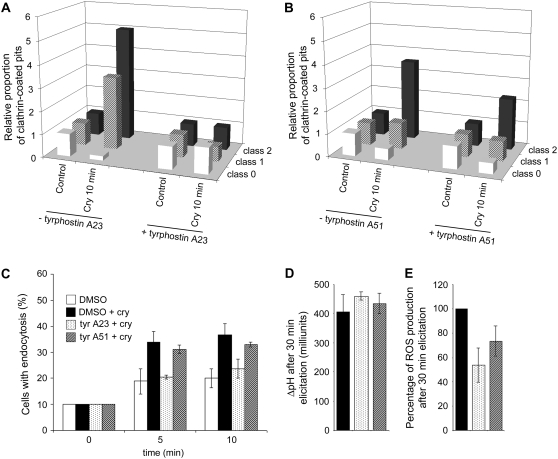Figure 5.
Tyrphostin A23, but not tyrphostin A51, prevents endocytosis in cryptogein-elicited BY-2 cells (A and B). Quantification of CCPs per 100-μm plasma membrane of 7-d-old BY-2 cells imaged by TEM. A, Relative increase of CCPs in elicited cells was compared in the presence and absence of tyrphostin A23. B, Relative increase of CCPs in elicited cells was compared in the presence and absence of tyrphostin A51. C, Seven-day-old BY-2 cells were labeled with FM4-64 (4.25 μm) for 5 min (0 min), then incubated with 0.1% DMSO (white columns), 0.01% DMSO plus 50 nm cryptogein (black columns), 5 μm tyrphostin A23 plus 50 nm cryptogein (spotted columns), or 5 μm tyrphostin A51 plus 50 nm cryptogein (dashed columns) under constant agitation at 23°C in the dark. BY-2 cells (n approximately 30–50) presenting full endocytosis (>10 vesicles) were quantified as described in Figure 2B. D, Extracellular ΔpH was measured in cells challenged with 50 nm cryptogein for 30 min in presence of 0.1% DMSO (control, black columns), 5 μm tyrphostin A23 (spotted columns), or 5 μm tyrphostin A51 (dashed columns). All treated cells exhibited extracellular alkalinization and no significant difference was observed. E, Effect of 5 μm tyrphostins on cryptogein-induced extracellular ROS production during the first 30 min after elicitor treatment. Total ROS production measured during 30 min of treatment by cryptogein was summed and expressed in percentage of ROS production in cells treated with cryptogein plus DMSO. Cells treated with cryptogein plus DMSO (black columns), cryptogein plus 5 μm tyrphostin A23 (spotted columns), or cryptogein plus 5 μm tyrphostin A51 (dashed columns).

